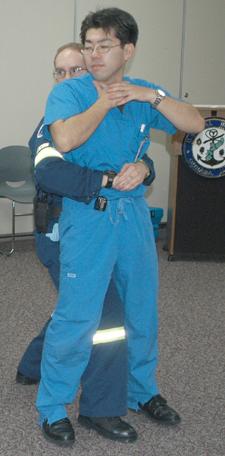
Choking

Choking (also known as foreign body airway obstruction) is a life-threatening medical emergency characterized by the blockage of air passage into the lungs secondary to the inhalation or ingestion of food or another object.Choking is caused by a mechanical obstruction of the airway that prevents normal breathing. This obstruction can be partial (allowing some air passage into the lungs) or complete (no air passage into the lungs). The disruption of normal breathing by choking deprives oxygen delivery to the body, resulting in asphyxia. Although oxygen stored in the blood and lungs can keep a person alive for several minutes after breathing stops, this sequence of events is potentially fatal. Choking was the fourth most common cause of unintentional injury-related death in the US in 2011. Choking (also known as foreign body airway obstruction) is a life-threatening medical emergency characterized by the blockage of air passage into the lungs secondary to the inhalation or ingestion of food or another object.Choking is caused by a mechanical obstruction of the airway that prevents normal breathing. This obstruction can be partial (allowing some air passage into the lungs) or complete (no air passage into the lungs). The disruption of normal breathing by choking deprives oxygen delivery to the body, resulting in asphyxia. Although oxygen stored in the blood and lungs can keep a person alive for several minutes after breathing stops, this sequence of events is potentially fatal. Choking was the fourth most common cause of unintentional injury-related death in the US in 2011. According to the National Safety Council (NSC), deaths from choking most often occur in the very young (children under 1 years old) and in the elderly (adults over 75 years). Obstruction of the airway can occur at the level of the pharynx or the trachea. Foods that can adapt their shape to that of the pharynx (such as bananas, marshmallows, or gelatinous candies) can be a danger not just for children but for persons of any age. Choking is one type of airway obstruction, which includes any blockage of the air-conducting passages, including blockage due to tumors, swelling of the airway tissues, and compression of the laryngopharynx, larynx or vertebrate trachea in strangulation. Choking is caused by an object from outside the body, also called a foreign body, blocking the airway. The object can block the upper or lower airway passages. The airway obstruction is usually partial but can also be complete. Among children, the most common causes of choking are food, coins, toys, and balloons. In one study, peanuts were the most common object found in the airway of children evaluated for suspected foreign body aspiration. Foods that pose a high risk of choking include hot dogs, hard candy, nuts, seeds, whole grapes, raw carrots, apples, popcorn, peanut butter, marshmallows, chewing gum, and sausages. The most common cause of choking death in children is latex balloons. Small, round non-food objects such as balls, marbles, toys, and toy parts are also associated with a high risk of choking death because of their potential to completely block a child's airway. Children younger than age three are especially at risk of choking because they explore the environment by putting objects in their mouth. Also, young children are still developing the ability to chew food completely. Molar teeth, which come in around 1.5 years of age, are necessary for grinding food. Even after molar teeth are present, children continue developing the ability to chew food completely and swallow throughout early childhood. In addition, a child's airway is smaller in diameter than an adult's airway, which means that smaller objects can cause an airway obstruction in children. Infants and young children generate a less forceful cough than adults, so coughing may not be as effective in relieving an airway obstruction. Finally, children with neuromuscular disorders, developmental delay, traumatic brain injury, and other conditions that affect swallowing are at an increased risk of choking. In adults, choking often involves food blocking the airway. Risk factors include using alcohol or sedatives, undergoing a procedure involving the oral cavity or pharynx, wearing oral appliances, or having a medical condition that causes difficulty swallowing or impairs the cough reflex. Conditions that can cause difficulty swallowing and/or impaired coughing include neurologic conditions such as strokes, Alzheimer disease, or Parkinson disease. In older adults, risk factors also include living alone, wearing dentures, and having difficulty swallowing. Children and adults with neurologic, cognitive, or psychiatric disorders may experience a delay in diagnosis because there may not be a known history of a foreign body entering the airway. Providers such as pediatricians and dentists can provide information to parents and caregivers about what food and toys are appropriate by age to prevent choking. The American Academy of Pediatricians recommends waiting until 6 months of age before introducing solid foods to infants. Caregivers can supervise children while eating or playing. Also, caregivers can avoid giving children younger than 5 foods that pose a high risk of choking such as hot dog pieces, cheese sticks, cheese chunks, hard candy, nuts, grapes, marshmallows, or popcorn. Parents, teachers, child care providers, and other caregivers for children get training in choking first aid and cardiopulmonary resuscitation (CPR).
